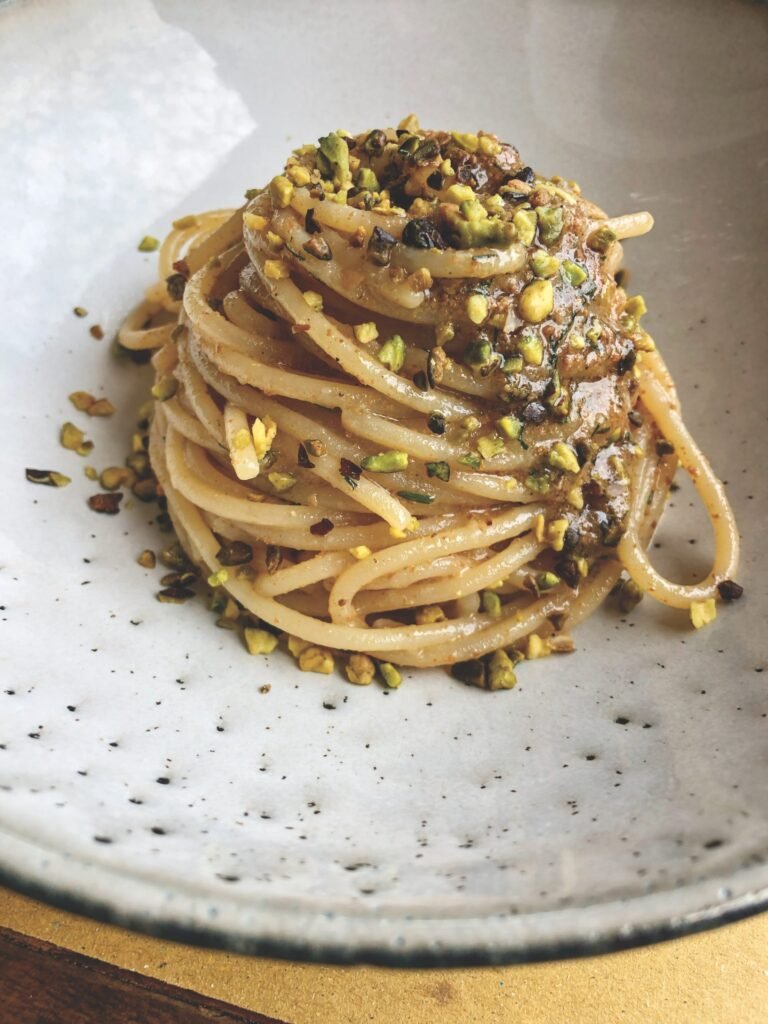
Certain brand names become eponymous with the products or foods they represent. Even in this new era of heightened awareness of Italian regional cuisines, the word “pesto” has met a similar fate, becoming synonymous with a specific version: pesto alla genovese, a blend of basil, pine nuts, garlic, olive oil, and grated cheese from Genoa in Liguria. But pesto isn’t defined by a single city’s tradition, and it’s not unique to northwestern Italy. It can be any pasta sauce made by mashing together ingredients in a mortar and pestle (or blending them in a food processor) and is typically composed of herbs, nuts, cheese, and olive oil.
If there’s a pesto capital of Italy, it’s Sicily, where Trapani and the islands of Linosa and Pantelleria (not to mention the Aeolian chain) all have their own versions. The recipes that follow (from my cookbook Food of the Italian Islands) are for specific regional pestos, but you can get creative and invent your own with what you have in your pantry using this formula:
1 to 2 bunches herbs + 1 cup nuts + ½ cup grated aged cheese or 3 tablespoons salted capers + 2 garlic cloves + salt to taste + ¼ cup extra-virgin olive oil
Just be sure to add the olive oil after blending the primary ingredients and to stir in the cheese at the very end. You can add other ingredients you fancy, too, like tomatoes, as they do in Trapani, Pantelleria, and Linosa. And you can even make your original recipe dairy-free by omitting the cheese, Linosa, Pantesco, and Aeolian style!
Food Processor vs. Mortar and Pestle
Let’s face it—making pesto with a mortar and pestle is romantic, but not always practical when you have to get dinner on the table. Most Italians today use a food processor to make pesto, and you can too. But, if you prefer the old-school-mortar-and-pestle method, here’s how to do it:
Combine the nuts, garlic, herbs, capers (if using), and a heavy pinch of salt in the mortar and mash them into a paste with the pestle. Add a bit of olive oil, but only as much as the herbs need in order to hydrate into a paste—no more than ¼ cup. If you add too much oil, the herbs will turn from green to blackish. When you have a smooth paste, transfer it to a separate bowl and mix with any other ingredients the recipe calls for. Serve with pasta, tossing well to coat.
Pesto Eoliano | Pesto from the Aeolian Islands
Drawing on Sicilian produce in general, Aeolian pesto combines pistachios from Mount Etna, almonds from Noto, and the islands’ own salted capers.
Makes 3 cups pesto, to serve 4 to 6
1 pound Roma (plum) tomatoes, blanched and peeled (see Tip below), then roughly chopped
¼ cup shelled unsalted raw pistachios
½ cup blanched almonds
2 tablespoons salted capers, rinsed, soaked until their saltiness mellows, then drained
Leaves from 1 bunch basil (about 1 packed cup)
2 garlic cloves, peeled
Fine sea salt
¼ cup extra-virgin olive oil
1 pound dried or fresh pasta
Follow the method below.
Pasta cu L’Agghia | Pesto from Trapani
Pasta cu l’agghia is a dialect phrase from western Sicily that means more or less “pasta with garlic.” It’s not quite that simple, as the ingredients list confirms. It was likely born as an enriched version of a peasant dish made from grated or chopped tomatoes marinated with garlic. In Italian, the dish is called pesto alla trapanese, “pesto in the style of Trapani.”
Makes 3 cups pesto, to serve 4 to 6
1 pound Roma (plum) tomatoes, blanched and peeled (see Tip below), then roughly chopped
Leaves from 1 bunch basil (about 1 packed cup)
1 cup blanched almonds, roughly chopped
2 garlic cloves, peeled
Fine sea salt
¼ cup extra-virgin olive oil
½ cup finely grated Pecorino Romano cheese
1 pound busiate or spaghetti
Follow the method below.
Pesto di Pistacchi | Pistachio Pesto
Made from herbs and ground pistachios from around Mount Etna, this has become a modern classic and is served all across the island and even on the mainland as an ode to Sicily. The pistachios are the star here in the absence of tomato and the bright green hue is as alluring as Sicily itself.
Makes 1½ cups pesto, to serve 4 to 6
1 cup shelled, unsalted raw pistachios
Leaves from 1 bunch basil (about 1 packed cup)
Leaves from 1 bunch mint (about 1 packed cup)
2 garlic cloves, peeled
Fine sea salt
¾ cup extra-virgin olive oil
½ cup finely grated aged caciocavallo or Pecorino Romano cheese
1 pound fresh or dried pasta
Follow the method below.
Pesto Pantesco | Pesto from Pantelleria
Pesto pantesco embraces the wonderful, savory flavor of Pantelleria’s most famous export, salted capers.
Makes 3 cups pesto, to serve 4 to 6
1 pound Roma (plum) tomatoes, blanched and peeled (see Tip below), then roughly chopped
1 cup blanched almonds, roughly chopped
3 tablespoons salted capers, rinsed, soaked until their saltiness mellows, then drained
Leaves from 1 bunch basil (about 1 packed cup)
Leaves from 1 bunch mint (about 1 packed cup)
2 garlic cloves, peeled
Fine sea salt
¼ cup extra-virgin olive oil
1 pound dried or fresh pasta
Follow the method below.
Method
Bring a large pot of water to a rolling boil over high heat.
Meanwhile, in a food processor, combine all the ingredients except for the olive oil, cheese (if the recipe calls for it), and pasta, then pulse until chunky. Slowly add the olive oil and process until smooth.
Transfer the pesto to a large bowl. Stir in the cheese, if using.
When the water comes to a boil, add salt until it tastes like a seasoned soup. Add the pasta and cook until al dente if it’s dried, or until it floats and loses its raw flavor if it’s fresh. Drain the pasta, reserving some of the cooking water. Add the pasta to the pesto and stir to coat. Add some of the reserved cooking water a spoonful at a time as needed to loosen the sauce. Taste and add salt, if necessary.
TIP: To Blanch and Peel Tomatoes
Bring a large pot of water to a boil over high heat. Fill a large bowl with ice and water and set it nearby. Meanwhile, core the tomatoes and cut an X in the other end. Place the tomatoes in the boiling water for 10 to 15 seconds, then remove with a slotted spoon and transfer to the ice bath. Allow to sit for 1 minute, then drain.
Peel the tomatoes with a paring knife, halve them, and scrape out any remaining seeds.
Pesto alla Carlofortina | Pesto from the Isola di San Pietro
Of all the pesto recipes, this is the one that looks the most like pesto alla genovese, which makes sense because Carloforte on the Isola di San Pietro was founded by fishermen from the region of Liguria. The addition of tuna is a nod to the island’s main export.
Makes 2 cups pesto, to serve 4 to 6
For the tuna:
12 ounces fresh tuna, cut into ½-inch pieces
Sea salt
2 tablespoons extra-virgin olive oil
¾ cup cherry tomatoes, halved
For the pesto:
1 cup pine nuts
Leaves from 1 bunch basil (about 1 packed cup), plus more for garnish
1 garlic clove, peeled
¾ cup extra-virgin olive oil
½ cup freshly grated Parmigiano-Reggiano cheese
1 recipe fresh trofie or 1 pound dried pasta
Make the tuna: Season the tuna on both sides with salt. Heat the oil in a large pan over medium-high heat. When the oil begins to shimmer, add the tuna and cook just until it is firm and opaque, 2 to 3 minutes. Transfer the tuna to a plate and set aside. Add the tomatoes to the pan, season with salt, and cook until they soften, 4 to 5 minutes.
Make the pesto: Bring a large pot of water to a rolling boil over high heat.
Meanwhile, in a food processor, combine the pine nuts, basil, and garlic and pulse until chunky. With the processor running, slowly add the olive oil and process until smooth.
Transfer the pesto to a large bowl and fold in the Parmigiano-Reggiano and the tuna and tomatoes.
When the water comes to a boil, add salt until it tastes like a seasoned soup. Add the pasta and cook until it floats and loses its raw flavor if it’s fresh, or cook until al dente if it’s dried.
Drain the pasta, reserving some of the cooking water. Add the pasta to the pesto and stir to coat. Add some of the reserved pasta cooking water a spoonful at a time as needed to loosen the sauce. Season with salt to taste. Serve garnished with basil.
I like serving this dish as a primo before Calamari Ripieni (Stuffed Calamari).
Pesto di Broccoli e Mandorle | Broccoli and Almond Pesto
Inspired by my pesto-oriented island travels, like to gig cooked vegetables the pesto treatment, subbing them for the herb component. Broccoli and cauliflower and any of their relatives are great for making a sweet, creamy condiment with wonderfully layered flavors reminiscent of the islands’ winter vegetable recipes. Cook the pasta in the broccoli water to maximize flavor and minimize waste.
Makes 1½ cups pesto, to serve 4 to 6
Fine sea salt
1 pound broccoli, separated into florets, stalks cut into 1-inch pieces
¼ cup plus 2 tablespoons extra-virgin olive oil
2 garlic cloves, smashed and peeled
1 cup blanched almonds, roughly chopped
1 cup finely grated Pecorino Romano cheese
1 pound dried or fresh pasta (I like rigatoni)
Bring a large pot of water to a boil over high heat. Salt the water until it tastes like a seasoned soup. Add the broccoli and cook until soft, 4 to 5 minutes. Use a strainer or spider to transfer the broccoli to a bowl and set aside. Keep the water in the pot at a boil.
Heat ¼ cup of the olive oil in a large skillet over low heat. When the oil begins to shimmer, add the garlic and cook until the garlic just turns golden, about 3 minutes. Add the broccoli, season with salt, and increase the heat to medium-high. Cook, covered, stirring occasionally, until the broccoli is super soft and nearly falling apart, about 10 minutes.
Transfer the broccoli and garlic to a food processor. Add the almonds and pulse until chunky. Slowly add the remaining 2 tablespoons of olive oil and blend until smooth.
Transfer the pesto to a large bowl. Stir in the pecorino.
Add the pasta to the broccoli cooking water (be sure it’s at a boil) and cook until al dente if it’s dried, or cook until it floats and loses its raw flavor if it’s fresh.
Drain the pasta, reserving some of the cooking water. Add the pasta to the pesto and stir to coat. Add some of the reserved pasta cooking water a spoonful at a time as needed to loosen the sauce. Season with salt to taste. Serve.
O’ Pistu Linusaru | Pesto from Linosa
O’ pistu linusaru, also called pesto paesano (country pesto) locally, mixes two types of herbs and two kinds of nuts, delivering a pleasant complexity to a frugal dish.
Makes 2½ cups pesto, to serve 4 to 6
1 cup blanched almonds
¼ cup plus 1 tablespoon extra-virgin olive oil
1 pound cherry tomatoes, halved
½ cup pine nuts, lightly toasted in a pan
1 bunch basil
1 bunch fresh flat-leaf parsley
Fine sea salt
1 pound dried or fresh linguine
Preheat the oven to 350°F.
Bring a large pot of water to a rolling boil over high heat. Spread the almonds over a rimmed baking sheet and toast in the oven until fragrant, 8 to 10 minutes. Remove from the oven and set aside to cool.
Meanwhile, heat 1 tablespoon of the olive oil over medium-low heat. Add the tomatoes and cook until they start to release their liquid, about 5 minutes. Turn off the heat and set aside.
In a food processor, combine the toasted almonds, pine nuts, basil, and parsley and pulse until chunky. With the processor running, slowly add the remaining ¼ cup olive oil and process until smooth.
Transfer the pesto to a large bowl, and stir in the tomatoes.
When the water comes to a boil, add salt until it tastes like a seasoned soup. Add the pasta and cook until al dente if it’s dried, or cook until it floats and loses its raw flavor if it’s fresh.
Drain the pasta, reserving some of the cooking water. Add the pasta to the pesto and stir to coat. Add some of the reserved pasta cooking water a spoonful at a time as needed to loosen the sauce. Season with salt to taste. Serve.



